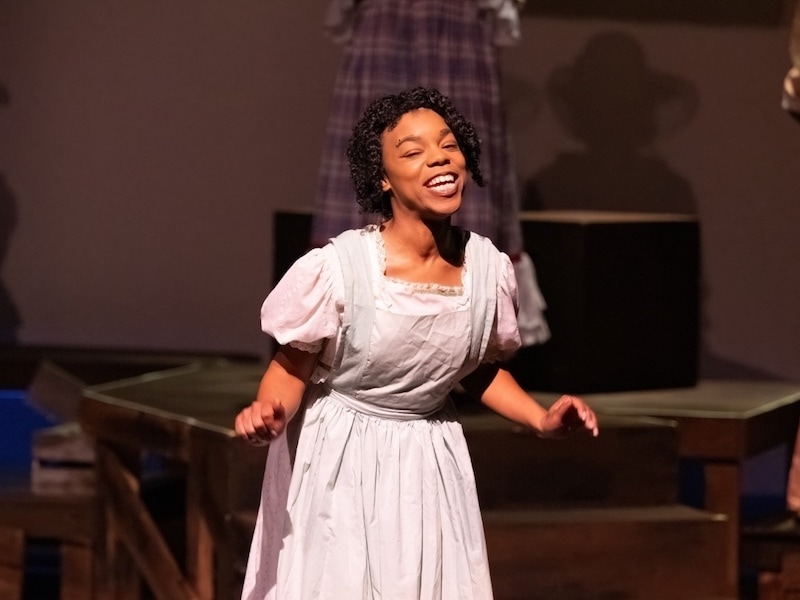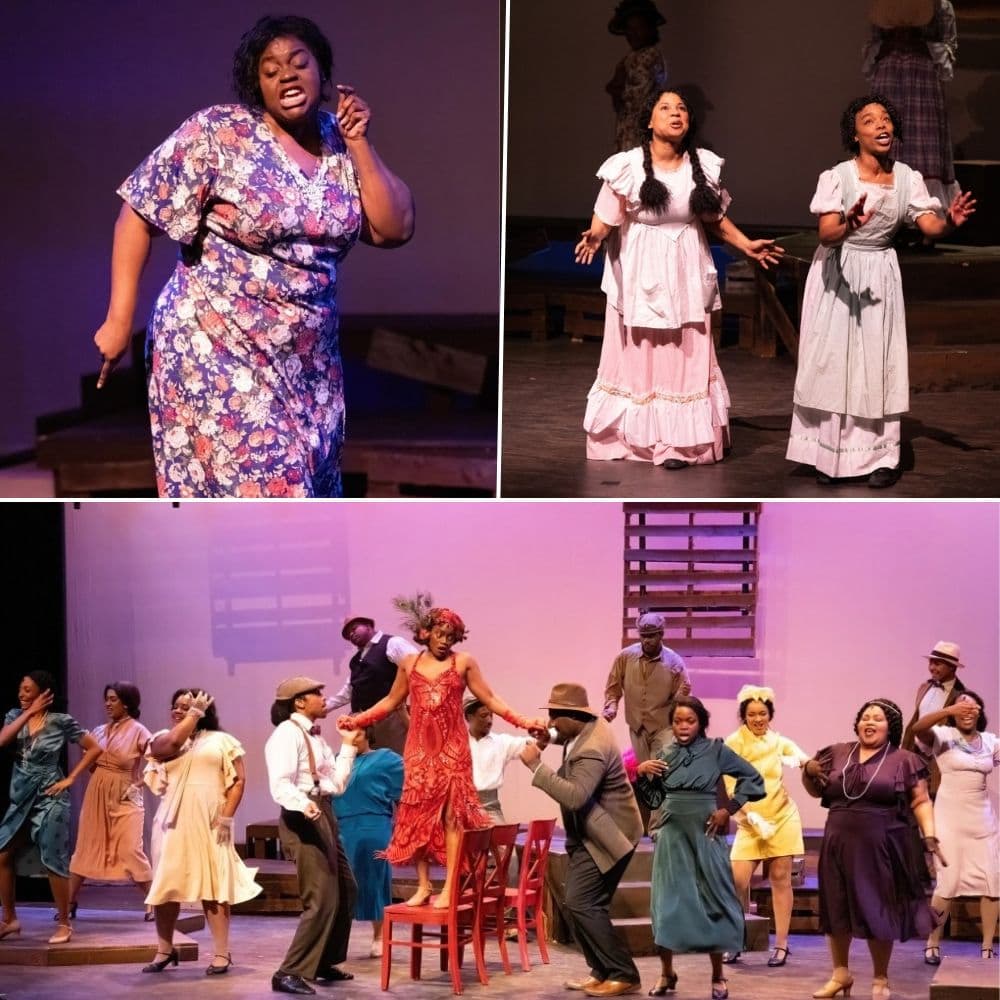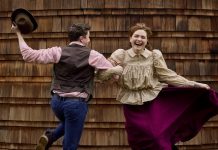By Teniola Ayoola
At the culmination of the performance, the cast and ensemble gather on stage for the final number, “The Color Purple.” Their voices resonate with such depth and perfect harmony that it feels as if they are singing from the depths of their souls, inviting us to “look at what God has done.” Indeed, under the direction of Kelly Chauncey and with contributions from the talented team at the BlackRock Center for the Arts (including the book by Marsha Norman and music and lyrics by Brenda Russell, Allee Willis, and Stephen Bray), The Color Purple musical we see stands as a marvelous achievement.
This musical transcends mere entertainment; it delves into themes of love, resilience, and redemption, drawing from the Pulitzer Prize-winning novel by Alice Walker and the 2023 Warner Bros. motion picture adaptation. The central character, Celie, faces a life filled with hardship following the loss of her mother. From enduring rape at the hands of her supposed father to being separated from her children and sister, Nettie, Celie’s journey is one of profound struggle. However, amid the darkness, two influential women, Sofia and Shug Avery, enter her life, offering guidance and empowerment. Celie’s transformation and the redemption of others in this story instill hope in most who hear it.

If the story instills hope, then by God, the vocals reach out and pierce your soul, warm your heart, and hit almost every nerve as the cast hits every note. There are few speaking lines in this three-hour show, and that is a good thing because, except for a few, the actors fare better at singing than acting. Maella Spires shines in her role as Celie, and in each number she takes us on a journey through pain, joy, sorrow, and triumph. If you blink during the opening of Act I, you’ll miss Celie giving birth, but as she cradles the baby and sings “Somebody’s Gonna Love You,” we feel the warmth and softness of a mother envelope the theater. When life strikes again and Celie is forced to separate from her sister, Spires’ vocals carry her pain through the air and make our spines shiver. “Dear God,” she sing-shouts in punctuated drawn-out syllables, “bring back my Nettie!” In Act II when mature Celie sings, “I’m here,” this is another well-delivered, pivotal moment that Spires sings with grace, confidence, and self-assuredness. “I don’t need you to love me,” she says softly before bellowing, “I’m gonna hold my head up, gonna put my shoulder back…. I’ll stand as tall as the tallest tree.”
When Spires is not dazzling us with her voice on stage, another star sure is! Shanice Jones playing Sofia is just as good as (if not better than) Danielle Brooks, who played the character on Broadway and in the movie. Jones is a talented actress who not only delivers her speaking parts in a booming and commanding voice but takes on the same stomp, vocal inflections, and pivot-and-kick walk of Brooks. She delivers a strong and impassioned rendition of “Hell No!” We so feel Jones’ palpable anger and sheer refusal to tolerate an abusive man that we also catch that contagious feeling of empowerment.
The lineup of top-tier performers continues with Maya Strickland as Shug Avery. When she sings “Push Da Button” with such a mesmerizing display of talent and stage presence, we just about fall over on our knees, bowing and hailing her as the queen honeybee. With the help of wardrobe director Trena Elise, who stays true to the movie-musical rendition, Strickland appears from behind two big red feathers in a red sequined dress, red satin gloves, and red hat with feathers. She’s sultry, wild, and sexy walking on chairs, twirling around, whining, and grinding on men as she teaches us how to turn a man on: “If you want to light your man on fire, you’ve got to start it real slow,” she sings in a drawn-out and seductive voice; meanwhile the ensemble transitions from slow dance to straight-up humping as the song crescendos.

The only noticeable lull in the performance was “Mister’s Song” in Act II. Given that Edwin Michael Sheriff had only three weeks to prepare for his role as Mister, it is commendable that he fit right in without forgetting a line. However, in this number where we are to witness the inner turmoil of a man who now has to deal with the consequences of his evil deeds, the singing fails to impress this depth. In his speaking lines, Sheriff could improve on displaying the detached coldness and cruel disregard of Mister. Instead, he bucks around at the audience in the aisle and frequently darts suddenly at the other characters on stage in jerking movements. He holds on to his whip and glass cup for moral support but could do very well without either.
The ensemble cast further elevates the production with dynamic performances. Their singing, dancing, and commentary on the unfolding events add humor and fill the gaps in this tell-don’t-show musical. In the Act I “Opening / Mysterious Ways,” the ensemble takes us to a Southern Baptist church with a full praise break, dancing, clapping, and stomping. We see them later on as Sofia’s sisters and as gossipy Southern ladies offering their two cents on everyone else’s business: “I heard about poor child Celie, already brewing two childs … Who da daddy? Who da daddy?” About Sofia and Harpo: “He run into a tree and her name Sofia!” About Shug Avery: “She a woman of low moral character and that’s a-a-a-a-all we got to say.” Julian Spires’ music/vocal direction shines through particularly in the ensemble’s harmony.
GiGi Hunter is an exceptional choreographer, though in “Brown Betty,” the gents each dance around a chair, which they flip on the floor and then have to bend and pick back up several times — a movement that was noticeably laborious for some of the dancers and snagged away at what would have otherwise been a smooth dance number. Kelly Chauncey’s choreography for “Africa Part 1, Part 2,” which includes variations of the West African Wango, depicts a high-energy, upbeat, fast-paced traditional African dance hailing from Alice Walker’s made-up Olinka tribe. Wardrobe director Trina Elise again makes an impressive statement when colors burst onto the set in bright-colored African fabrics tailored into skirts, dresses, bandeaus, and headwraps. She does the same when mature Celie sings “In Miss Celie’s Pants” in Act II, dazzling the audience in light-up pants that flicker from blue to green to pink to yellow while the ensemble twirls around in a color assortment of satin pants with neat bows down the seam and around the hem. The scenes are further enhanced with lighting by Jordan Hersh and sound effects by Lucien Reubens. Wig designer Tula did an awesome job showing the progression of age in the characters. However, the front of mature Celie’s gray wig looks like it was caught in a hornet’s nest and could be better styled.
All of this would not have been possible without the talented instrumentalists from the Duke Ellington School of the Arts, Paul Carr’s Jazz Academy Ensemble, MC Jazz Ensemble, and James Hubert Blake High School, all of whom we heard clearly and beautifully but did not see. (It is worth noting that at times the musicians drowned out the vocals.) Other cast members Moyston Henry as Pa and lead dancer, Silas Holloway as Harpo, Kurtland Elliott as Henry Broadnax “Buster,” Kirjah Hoops as Squeak, Reva Ryann Thompson as Olivia, and Pierce Pearson as Adam are each exceptional in their roles.
I and dozens of others crowded into the BlackRock Center theater to see The Color Purple musical come to life again on stage. Despite some personal and casting setbacks (announced after the curtain call), we got so much more than we bargained for, and not until our hearts were filled did we realize how hungry we had been for a local musical production of this caliber.
Running Time: Three hours including a 15-minute intermission.
The Color Purple plays through April 21, 2024, at BlackRock Center for the Arts, 12901 Town Commons Drive, Germantown, MD. Purchase tickets ($42–$57) online.
The cast and creative team credits for The Color Purple are here.
COVID Safety: It is highly encouraged that all visitors wear a mask. See BlackRock’s Safety Measures.
 Teniola Ayoola is an arts and culture enthusiast. In her free time, you can find her at an art gallery, an art museum, or at the theater. She has an undergraduate degree in Journalism and Mass Communication from the School of Media and Public Affairs at George Washington University. She has had opportunities to work with the British Broadcasting Corporation (BBC), intern with the Shakespeare Theatre Company, and receive mentorship as a White House Correspondents Association Scholar. She recently graduated with her master’s in Management from Harvard University and is now part of the “Theater U” program for art critics with DC Theater Arts. Follow her on X @TopTeniola!
Teniola Ayoola is an arts and culture enthusiast. In her free time, you can find her at an art gallery, an art museum, or at the theater. She has an undergraduate degree in Journalism and Mass Communication from the School of Media and Public Affairs at George Washington University. She has had opportunities to work with the British Broadcasting Corporation (BBC), intern with the Shakespeare Theatre Company, and receive mentorship as a White House Correspondents Association Scholar. She recently graduated with her master’s in Management from Harvard University and is now part of the “Theater U” program for art critics with DC Theater Arts. Follow her on X @TopTeniola!





This review beautifully encapsulates the profound impact of “The Color Purple” musical. From the depths of its themes to the soaring vocals and powerful performances, every aspect of the production resonates with authenticity and passion. Reading about Maella Spires’ moving portrayal of Celie, Shanice Jones’ commanding presence as Sofia, and Maya Strickland’s mesmerizing performance as Shug Avery, I feel I’ve already been transported into the heart of the theater. The review’s attention to detail, from the dynamic choreography to the impressive contributions of the ensemble and production team, only adds to my anticipation of experiencing this theatrical masterpiece firsthand. It’s evident that “The Color Purple” isn’t just a show—it’s an immersive journey into the resilience of the human spirit, and I can’t wait to be a part of it.
Thanks for this review. This is a wonderful write up. It seems like overall the show is worth a watch. And hopefully as it continues to run, the few rough edges you highlighted will be smoothened out. Thanks for the insight
A couple of correction on the instrumentalists:
Duke Ellington School of the Arts, Paul Carr’s Jazz Academy Ensemble, MC Jazz Ensemble, and James Hubert Blake High School….
Corrected. Thanks.